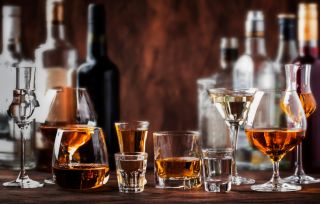Habit Formation
Why Life Can Seem Joyless Without Alcohol
An illusion created by habit, desire, and narrowed attention.
Updated July 7, 2023 Reviewed by Ray Parker
Key points
- Our brains program sequences of actions into habits to increase efficiency and conserve energy.
- A habit is an automated program that is activated by a cue and is fueled by the desire for a reward.
- Alcohol creates an illusion that is a by-product of habit, desire, and narrowed focus.

Have you ever been afraid that life would become joyless if you quit alcohol?
“But nothing seems as fun as drinking,” is one complaint that most of my clients have voiced to me in our conversations. I get it—during my drinking days, I too often wondered whether there was any appeal in living a long and healthy life if that meant living it without booze.
Now, years into sobriety, I realize that life offers countless sources of joy—most far more vibrant than the mind-numbing buzz I got from booze. The joyless life I once imagined was nothing but an illusion created by my brain, a by-product of habit, desire, and narrowed focus.
Automated Programs: Habits
Habits, or automated sequences of actions, are the building blocks of our daily life. Each day, we unknowingly perform dozens—if not hundreds, of habits—from brushing our teeth to saying, “Thank you” to a compliment. These automated programs help our brains increase efficiency and conserve energy.
A habit consists of three parts: a cue, a routine, and a reward. A reward is the end goal, a desired outcome that allows the brain to know which sequence of actions is worth remembering. A routine is the sequence of actions that produce a desired outcome. A cue is any kind of stimulus that signals the brain to activate a particular routine.
With sufficient repetition, the three components form a habit loop within the brain. Action becomes automation and the brain ceases to fully participate in the program. The cue of morning breath activates the teeth-brushing routine to achieve the reward of fresh breath; no conscious effort is required. Without such automated programs, most of us will be paralyzed by the amount of mental energy that is required for just performing basic, daily functions.
The Fuel to the Automation: Desire
Desire is the fuel for this automation. Once we learn to link a cue with a reward, we start to anticipate the desired outcome when the cue enters our radar, and a habit loop is formed.
We learn, for example, to desire the freshness in our mouth when we taste the morning breath. The craving fuels the routine of teeth brushing. Depending on how desirable the reward is and how strong the anticipations are, the craving could range from minor discomfort to intense frustration.
MIT Habit Study
In the 1990s, a group of MIT scientists trained some monkeys to link colorful shapes that show up on the computer screen with the reward of receiving blackberry juice. When the monkeys correctly performed a routine, they got a sweet treat. The monkeys loved the blackberry juice, and a habit loop soon started to form, evidenced by the joy signal that started to spike inside their brains the moment that the monkeys saw the colored shape. They learned to anticipate the sweet treat.
After the monkeys fully learned the procedure, the scientists decided to delay the blackberry juice or water down the sweet treat to see how the monkeys would react. The monkeys were not happy about the change. Their brains lit up in ways that suggested unhappiness, and they became visibly frustrated or depressed whenever the anticipated reward failed to arrive. The joy of anticipation turned into the frustration of craving.
The very same process happens in the drinker's brains when they learn to link the buzz from alcohol with a cue, such as Friday night. When the “time to drink” cue enters the radar, the desire for a drink is activated. If the anticipated outcome fails to arrive, craving and frustration break through the mind.
There is an evolutionary purpose for this mechanism: Desire and craving motivate mammals to perform what is essential for their survival, such as foraging for food or pursuing a mate. How does this adaptive mechanism end up trapping drinkers in a world where alcohol seems to be the only thing worth pursuing? We have to take a look at how habit loops can narrow one’s attention.
Blindsight to Alternatives: Narrowed Attention
Desire can narrow down one’s attention and crowd out the appeal of other alternative pursuits. In the experiment, the monkeys who had formed a strong enough habit loop seemed to lose sight of any other opportunities—even though the scientists tried to distract the monkeys with alternative rewards, such as a treat on the other side of the room or playing outside.
The monkeys would remain glued in front of the monitor and perform the routine over and over again. The blackberry juice seemed to have become the only thing in their world that was worth pursuing. On the other hand, the monkeys who had not developed a strong enough habit would happily take the alternative rewards and leave the blackberry juice behind.
A highly ingrained habit loop appears to have the ability to make one lose sight of the appeal of alternatives. Once a cue is detected, the brain enters a focus mode and only one goal is left in sight: “Perform the routine and get the reward.” The intense desire narrows down the attention to nothing but one pursuit; the rest of the world fades into a colorless background.
Drinkers' Habit Loop
For many drinkers, drinking is a well-practiced habit. The habit loop of using alcohol to achieve a buzz has often been performed hundreds, if not thousands, of times. Like the monkey who sees nothing but the blackberry juice, a human can become blind-sighted to all other sources of fun when they become hooked by one well-practiced habit loop.
“Focus on what works” is a good strategy that aids survival and conserves energy. However, the unintended tunnel vision keeps the monkey glued in front of the monitor and the drinkers trapped inside the bottle.
Bursting the Illusion: Rediscover Joy
The truth is there is much more to a monkey’s happiness than blackberry juice—ripe bananas, sunshine on the grass, and a lady monkey who is swinging on the tree. Similarly, there is much more to a joy-filled life than the mind-numbing buzz offered by alcohol.
Don’t let your brain trick you into believing that alcohol is the only thing that is worth pursuing. As intense as the desire can be, you can learn to let it pass. Over time, the craving will dim in intensity and eventually subside. As real as the illusion can feel, you will slowly remember the true beauty life has to offer. Give it time, the rest of the world will light up and eventually return to its full, vibrant color.
If you are unsure about where to start, check out some of my favorite tools, including pairing a three-minute drinking diary with delayed drinking activities.
Facebook image: LanaVal/Shutterstock
LinkedIn image: Dragon Images/Shutterstock




